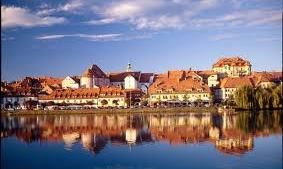
The Armenian Chess Secret
On the free day at the Jermuk Women's Grand Prix tournament way back in 2010, I had a pleasant opportunity to chat with the hosts. My conversation with the chief organizer and famous GM Smbat Lputian inevitably touched on the remarkable results that the Armenians had at the prior two olympiads. Is it all а question of excellent play, strong teamwork, or is there something else too?
I asked Smbat if they always do their preparation before the olympiad at a high mountain resort. “Yes, we do'” replied the GM, and continued with a joke:” and since we are very near God at this place (Jermuk is situated on an altitude of 2080 meters above the sea level), we pray for a win passionately, and he hears our prayers…”

The Armenian team playing Azerbaijan at the 2011 European Team Chess Championship. Photo | Andreas Kontokanis.
The altitude reminded me of something that we used to study in the National Sports Academy in Sofia. For a long time, the leading sportsmen in many countries have conducted their final preparations before important events in high-mountain conditions. Here is the explanation:
The atmosphere becomes thinner and thinner as the altitude increases. That also affects the partial pressure of oxygen. At an altitude of 5,500 meters (18,045 feet), the concentration of oxygen is 50% of the typical concentration at sea level. On the highest peak in the world, Mount Everest (8,848 meters and 29,029 feet), it is 32% of the concentration at sea level.

Mount Everest. #beautiful #cold
Oxygen exists in the atmosphere and the alveoli as a free gas, but in the blood, it is connected mostly with hemoglobin — the transport courier in the red blood cells.
When the partial pressure of oxygen decreases while climbing on high mountains, the blood pressure between the air in the alveoli and arterial blood is leveled. This hinders the saturation of hemoglobin with oxygen. The reduced oxygen segregation from the arterial blood to the tissues causes hypotrophy; that is to say hypoxia.
The good thing, as Nietzsche mildly put it a long time ago, is: “Everything that does not kill us; makes us stronger.” The human body possesses mechanisms that can compensate for this lack of oxygen. This is how adaptation is made possible. The primary reaction of the body is that breathing gets faster and deeper, and thus more oxygen reaches the lungs. (N.Sirotin, 1930; V. Samtzov, 1933; I. Dedyulin, G. Vladimirov, 1938).
Another of the body's mechanisms is increasing blood supply toward the lungs; that increases the reception of oxygen. The heart beats faster and stronger. For each unit of time, more oxygenated blood is sent from the lungs to the tissues.

Who'd have thought these little red blood cells were so complicated?!
In the facility in Jermuk, they offered us an oxygen cocktail in the form of foam. We needed to eat it quickly before it became a liquid.
However, the most important thing for our purposes is that hypoxia stimulates the marrow to produce extra quantities of red blood cells. Their quantity increases by approximately 20-25% after a stay of three to four weeks at an altitude of 4,000 meters or 13,123 feet (N. Sirotin, 1930). This increase is known as polyglobulia (O.Yoltz, 1979). The content of hemoglobin in the newborn cells is also increased.
This effect remains in the body some weeks after the sportsman returns to sea level. Sports specialists consider it a natural form of blood doping (absolutely legal) that helps the nutrition of the whole body, and more specifically, the brain.
Still, the Nepalese people cannot beat the Armenians in chess, which means that some features are more important than others.
In a time when there are so many contenders for the gold at the Olympics and abilities are so even, every improvement, no matter how negligible it might seem, can be of decisive importance.






